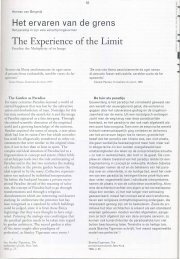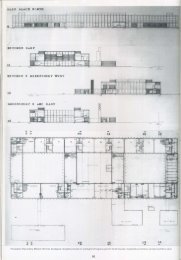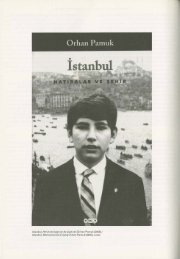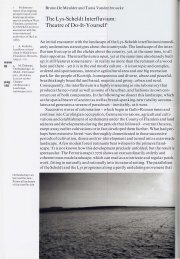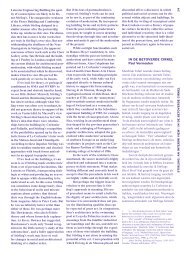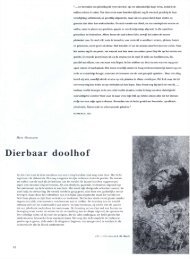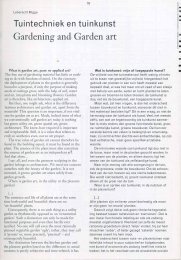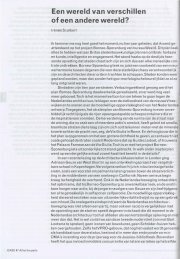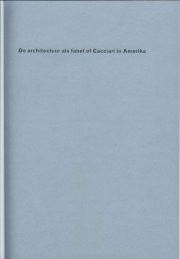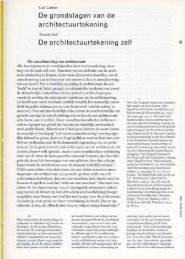OASE_49-50_182.pdf - OASE Journal for Architecture
OASE_49-50_182.pdf - OASE Journal for Architecture
OASE_49-50_182.pdf - OASE Journal for Architecture
Create successful ePaper yourself
Turn your PDF publications into a flip-book with our unique Google optimized e-Paper software.
swift consumption. There is hardly any time to develop the<br />
ease and ordinariness which characterises the anonymous or<br />
industrial buildings which are often in the architect's mind.<br />
'<strong>Architecture</strong> thicker than paper' would have to find a balance<br />
between <strong>for</strong>m and rejection of <strong>for</strong>m, standard and exception,<br />
order and tolerance, between the desire <strong>for</strong> innovation and<br />
engaging with the conventional and traditional. The lecture<br />
series was organised to develop these ideas further. One of the<br />
speakers was the London-based architect Adam Caruso: 'It is<br />
doubtful whether completely new <strong>for</strong>ms can exist. The imper<br />
ative assigned to the radically new - that such <strong>for</strong>ms have no<br />
connection to the past and are the harbinger of an enhanced<br />
future- is tautological, and fundamentally conservative. A<br />
more radical <strong>for</strong>mal strategy is one that considers and repre<br />
sents the existing and the known. In this way artistic produc<br />
lion can critically engage with an existing situation and<br />
contribute to an ongoing and progressive cultural discourse?<br />
This statement summarises some of the concerns dis<br />
cussed in the current issue of Oase. The work of Felix Claus<br />
and Kee Kaan addressess the same strategies which Adam<br />
Caruso refers to. However, a number of questions remain<br />
unanswered; questions about the nature and significance of<br />
'conventional architecture':<br />
1. Convention I commonplace<br />
and observation<br />
The collection of texts, articles and<br />
van de behoefte naar vernieuwing en het doorontwikkelen<br />
van het bestaande. 'Thicker than paper' werd georgani<br />
seerd om hierover verder na te denken. Onder andere werd<br />
de Londense architect Adam Caruso uitgenodigd als<br />
gastspreker: 'Het is onwaarschijnlijk dat volkomen nieuwe<br />
vormen daadwerkelijk bestaan. De verwachting die men aan<br />
het zogenaamd radicaal nieuwe stelt- dat zulke vormen<br />
geen verbinding hebben met het verleden en een voorteken<br />
zijn voor een zich duidelijk manifesterende toekomst-<br />
is tautologisch en principieel conservatief. Een <strong>for</strong>mele<br />
strategie die uiteindelijk veel radicaler is, is een strategie,<br />
die het bestaande en bekende juist wei overweegt en repre<br />
senteert. Op die manier kan de productie van een kunst<br />
werk kritisch op een bestaande situatie reageren en zo bij<br />
dragen aan een zich steeds vernieuwend cultureel debat.'<br />
Deze stelling vat een aantal ontwerpaspecten samen,<br />
die in de verschillende bijdragen van dit nummer zijn verza<br />
meld. Felix Claus en Kees Kaan hebben met hun inmiddels<br />
vrij omvangrijke oeuvre de door Adam Caruso bedoelde<br />
strategieen aan de orde gesteld en hiermee ook steeds<br />
weer vragen opgeroepen. Vragen over het belang en de<br />
betekenis van conventie:<br />
projects starts with the perception of the<br />
photographer's consciously directed view<br />
through the camera. In photography the<br />
precision of perception can be addressed<br />
directly. Photography is able to put<br />
<strong>for</strong>ward banal and trivial things, the well<br />
known and the too-well-known and lhere<br />
<strong>for</strong>e unnoticed. Choosing the subjects, the<br />
photographer pays special attention to<br />
them, expecting or even demanding the<br />
same from the viewer, <strong>for</strong>cing the viewer<br />
to rearrange and re<strong>for</strong>mulate the percep<br />
tion. A photographer exposes the subject<br />
by showing it. <strong>Architecture</strong> potentially has<br />
the means to evoke a similar attentiveness<br />
as well. If we talk about common things,<br />
we mean, in the first place, unconsciously<br />
perceived daily objects and images; in<br />
architectural terms: building elements<br />
like the (bay) window, the door, the stair<br />
to the door, the rooflight etc. In the daily<br />
use and the daily experience of cities,<br />
there are all these small things that attach<br />
a space, a building or a street to our<br />
memories.<br />
Claus & Kahn use the term observa<br />
tion to develop the strategies they talk<br />
about. How can observation of everyday<br />
185<br />
1. Conventie I gemeenplaats en<br />
waarneming<br />
Wij beginnen deze verzameling teksten en<br />
projecten in Oase met de bewust gerichte<br />
blik van de fotograaf door zijn camera.<br />
In de fotografie kan de precisie van de<br />
waarneming zonder omwegen aan de orde<br />
worden gesteld, de fotograaf kan onopge<br />
merkte, misschien bekende, banale of<br />
triviale dingen naar voren halen, onder de<br />
aandacht brengen en ervoor zorgen dat<br />
men er opnieuw en met andere ogen naar<br />
kijkt. Een fotograaf plaatst zijn onderwer<br />
pen in een nieuw Iicht, door ze te Iaten<br />
zien. Als architect heeft men hiervoor eve<br />
neens middelen in handen. Als wij het over<br />
het 'bekende' hebben, zijn dat in eerste<br />
instantie onopvallende, alledaagse dingen,<br />
bijvoorbeeld van bouwelementen zeals het<br />
raam, de erker, de deur, het trapje naar de<br />
deur, de dakkapel enzovoort. In het<br />
dagelijkse gebruik en de beleving van de<br />
stad zijn het vaak ongelooflijk kleine<br />
dingen, die- al dan niet onopgemerkt- een<br />
bouwwerk, een ruimte, een straat enzovoort<br />
in het onbewuste geheugen doen<br />
verankeren.<br />
Observatie is een begrip dat jullie<br />
graag gebruiken, observatie en strategie.<br />
Hoe kan de architectuur observerend te<br />
werk gaan, en welke veranderingen<br />
<strong>OASE</strong> # <strong>49</strong>/<strong>50</strong> 1998




